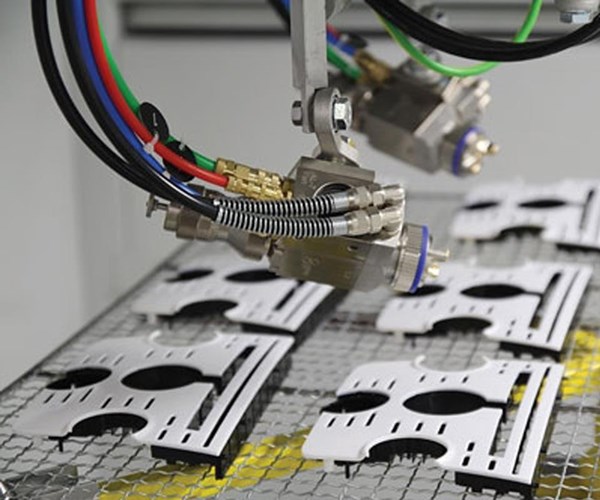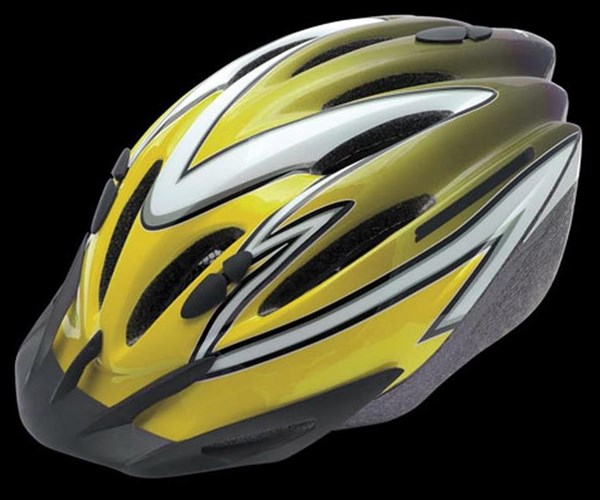Coating Plastic Parts More Efficiently
Quality, costs and sustainability in focus with liquid coatings.
#masking #sustainability #pollutioncontrol

In addition to reduced material consumption, the automated application (in this case a 3-axis machine) permits lower scrap rates and better reproducibility of the painting results. Photo courtesy of Sprimag.
Quality and individuality requirements are on the rise. At the same time, rising cost pressure and demand for environmentally sound production are making more efficient, flexible and resource-conserving painting processes necessary.
Featured Content
The number of plastic parts painted and coated is growing—and in a practically unlimited scope of diversity.
Not only are manufacturers in the automotive industry making more use of plastic parts, there’s hardly an area of life in which we’re not exposed to by plastics made primarily of macromolecules. Liquid coating processes are used when a product needs to be furnished with appealing optics, an individualized appearance, resistance against mechanical, chemical and physical stressing or special functional characteristics.
A number of challenges need to be met to this end. These include optimized quality along with strong economic efficiency and sustainability. This is further augmented by ever smaller lot quantities and an increasing variety of colors.
Recognizing Optimization Potential
Entrapped dirt particles and other painting defects result in high scrap and rework. Companies that paint plastic components are particularly impacted by this problem due to high levels of contamination beginning with the injection molding process and deburring, right on up to extensive overspray. In addition, the majority of plastics used today have a tendency to generate electrostatic surface charges, which attract contamination like a magnet.
In order to avoid painting defects and optimize quality, it pays to carefully scrutinize the entire process. When possible, this begins with a tooling design adapted to downstream painting requirements. For example, a reduced number of cutouts provides an optimized painting process, and rounded component edges can be more easily wetted with paint than sharp ones. Reducing deburring processes to a minimum also contributes to optimized quality—not only because residual burrs or particles resulting from removal of the sprues can lead to stray contamination all the way into the painting booth.
The cleanliness of the tools plays a role as well: Painting defects and entrapped dirt particles can be caused by an accumulation of the ingredients of the plastics used.

Due to the flame’s complex combustion chemistry, flaming changes the surface characteristics of the plastic substrate such that it is more readily wettable. Photo courtesy of Aerogen.
Optimized Cleaning, Activation
Formulating constituents such as release agents, additives, filler materials and fibers frequently provide plastics with good processing and functional characteristics. However, if they end up on the surface, they may impair paint adhesion.
A further challenge is the minimal surface energy demonstrated by many plastics. The trend toward water-based paints and process-reduced coatings is placing greater demands on substrate surfaces, so reliable cleaning or pretreatment is indispensable—creating a trend toward dry processes such as CO2 snow-jet, plasma and steam cleaning with superheated steam. In addition to making ecological sense, these processes frequently save costs, reduce space requirements and enable integration of the cleaning process into the painting line.
Electrostatic charging of the plastic surfaces can be counteracted by means of ionization. In order to avoid adhesion problems with difficult-to-paint, non-polar plastics such as polypropylene (PP) and polyethylene (PE), their surfaces are activated before painting. Common processes include gas phase fluorination, atmospheric-pressure plasma activation, corona treatment and flaming.

Formulated with innovative raw materials, the quality levels of the new water-based Berlac Hydro product series are equivalent to those of conventional solvent-based systems with regard to optics and durability. Photo courtesy of Berlac.
Highly Streamlined Painting
Reducing the number of process steps makes a considerable contribution to the goals of increased efficiency and reduced cost per unit. Thus, the trend is moving toward painting processes—either water-based or solvent—that provide desired results with a single coat. Other approaches to streamlining the painting process involve the eradication of possible causes of loss such as atomizer overspray and color changeover, as well as losses due to color changeover. Amongst other options, this can be accomplished through the use of electrostatically supported paint guns and high-speed rotary atomizers, which achieve application efficiency levels of greater than 90 percent. Application systems that enable minimized use of rinsing agents and shortened color changeover times further support cost-cutting measures.
The trend toward automated application remains strong as well. In addition to reduced material consumption, it also results in better reproducibility, lower scrap rates and cost savings due to the ease of switching from fresh exhaust air systems to recirculating air for conditioning the paint booth. Users can achieve energy savings of 60 to 70 percent.
Intelligent paint logistics also result in reduced material consumption, distinguished by the recovery of unused paint from feed lines and dosing of defined quantities of paint to the application equipment for special paint coatings. This assures frugal paint use, even when coating small manufacturing lots.
In addition to dryers, overspray removal is one of the hungriest energy consumers in the painting process. Where conventional paint drying is concerned, optimized air routing through sluice and tunnel areas, as well as improved heating units and waste-heat utilization systems assure pennywise consumption of costly energy. Infrared drying offers an alternative that can also be used for temperature-sensitive workpieces. The radiation penetrates the material and dries the paint layer from the inside out. This prevents the occurrence of a skin or bubbles on the surface, and paint drying is accelerated.
Conventional wet scrubbing for overspray consumes a great deal of energy and water. Dry scrubbing systems can be used to obtain savings in this area. Various solutions are available that make use of different scrubbing methods such as brushes, electrostatics, powder and special carton constructions.
Paint Systems Matched to Requirements
Fundamentally, high quality, efficient painting of plastics necessitates a paint system that is ideally matched to the substrate, the system technology and the specified requirements for the finished product. In the case of solvent-based paints, still widely used for coating plastics, emissions are significantly reduced by very-high and ultra-high-solid paint systems. Water-based paint systems continue their advance, too.
New developments with formulations based on innovative raw materials reach the same quality levels and the durability of conventional solvent-based paints. Depending on the degree to which the surfaces are subjected to stressing, they’re available as multi-coat systems consisting of a primer, a basecoat and a clear coat (or top coat and clear coat), or as a single-coat surface finish with single or 2-component systems including a range of colors and effects. The systems are individually matched to the application’s respective requirements and process conditions.
Amongst others, new developments in the field include a system specially developed for coating carbon-fiber-reinforced plastics. It’s distinguished by good adhesion, high levels of UV stability and resistance to scratching and chemicals in accordance with automotive standards. The coating system is based on a transparent primer with excellent durability. This makes it possible to obtain large layer thicknesses per application and thus to effectively and economically conceal surface defects in composite materials. The highly transparent clear coat, matched to the primer and the substrate, protects the material.
Doris Schulz is with PaintExpo, a leading international trade fair for industrial coating technology. Visit paintexpo.de.
RELATED CONTENT
-
Preventing Solvent Pop
Preventing solvent pop on an industrial paint line...
-
Paint Application Methods
An overview of spraying, dipping, flow coating, and everything in between.
-
Pretreatment for Painting
Better adhesion, enhanced corrosion and blister resistance, and reduced coating-part interactions make pretreatment a must.



















